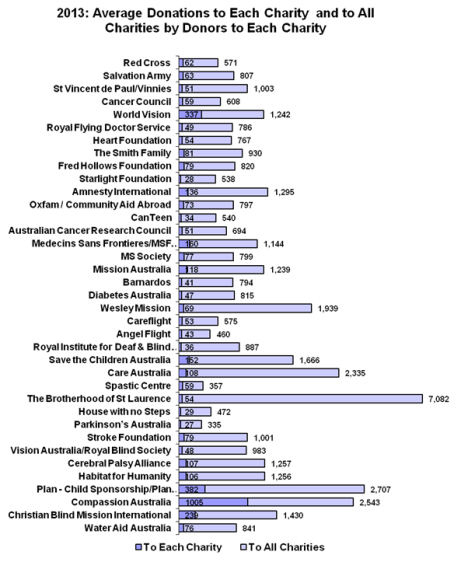What is the most effective method for charity fundraising?
Recent pieces on Mumbrella around charity street fundraisers have stirred debate about the pros and cons of the practice. Here Angela Brooks looks at what the statistics show is the best way of fundraising.
Following Mumbrella’s recent stories on the pro’s and con’s of ‘chuggers’, I thought it may be of value to reveal what the statistics show is the best fundraising strategy for charities and how to secure more out of the Australian hip pocket. The results will surprise many.
For over 20 years McNair Ingenuity Research has conducted an annual survey on the awareness and support of major charities. This subscription survey allows charities to understand where they sit in the market, recognise what motivates donors, how to secure the most donations for the investment made and other key strategies.
It tells us is that in fact street fundraising or ‘chugging’, while tempting to many charities as an obviously cost effective choice, is not the most successful option. Rather a mix of media awareness, supported by direct targeted approaches, such as door to door or direct mail campaigns, keeps the investment lower and the donor level and contribution high.
In this day and age with literally thousands of different charities to support, and the average number of charities that a person donates to 3.3, there is little room to get the marketing mix wrong. Charities, like their commercial counterparts, must continuously look for creative ways to effectively fundraise.
Since most people are likely to donate to the charities that they know best, the first and foremost consideration is AWARENESS if you want more donors. The results clearly demonstrate that the number of donors positively correlates with top of mind, unprompted awareness. Generally respondents remember three to five charities when asked and donate to the same number and usually the same charities. To gain awareness charities can use one of two methods:
1. Media and communication tools such as advertising, social media or public relations campaigns
2. Targeted approaches such as face to face in the street or door knocking, direct mail or email campaigns.
The first method is expensive and most charities can only afford to run media campaigns once a year at most. Over the years McNair Ingenuity Research has evaluated the effect of a variety of awareness campaigns for charities and the lessons learned are the same – provide a clear strong message and ensure that you have enough media weight to reach your target audience.
It is the second method that is more interesting. There is a strong positive correlation between being directly approached and donating. The benefit of targeted approaches is that it builds awareness as well as revenue, achieving two goals for the price of one. However, our data shows that there has been a steady decline in direct approaches, with 66 per cent of people saying they have been approached by a charity in the last year, down from 88 per cent in 2009. Are charities too afraid to ask directly for money? Perhaps they do not know how to ask?
The way people are asked to donate is critical and different donation methods will result in different outcomes. The data from our annual survey tells us that the most popular way to give to charities is by donating to collection tins (72 per cent say they are likely to donate this way). On the other hand only 26 per cent of respondents will sign up to make a regular donation when approached on the street by ‘Chuggers’. 53 per cent are likely to give to a door to door appeal. Interestingly, the two charities (Salvation Army and Red Cross) that regularly conduct door to door appeals, have the highest awareness AND the most number of donors, coupled with media campaigns that advertise the door knock appeals.
But there is another essential consideration. Those charities that are most successful at getting the most number of donors are also likely to have the lowest average donation amount. The top 5 charities by number of donors are: Red Cross, Salvation Army, Cancer Council, St Vincent de Paul and Heart Foundation. The average donation to each of these charities ranges from $51 – $63, whereas number six on the list, World Vision, gains an average donation of $376 per person.
How? They use sponsorship as their major fundraising activity to ensure the highest per capita donations.
People who give by the most popular method of donation, collection tins, will average about $194.00 per year in donations. People who give door to door will average $206.40 per year, but people who make regular donations by their credit cards will donate more than twice that amount in year ($444.40). World Vision Australia has a stranglehold on the market, consistently receiving between 30 per cent and 40 per cent of all money donated to development NGO’s. What makes World Vision successful is their high awareness, built by the use of strong media campaigns over many years, and a high-price revenue model.
Thus it’s clear that for a charity to successfully fund raise it needs to make a long term investment in media to increase top of mind awareness, supported by direct approaches to keep their donor level high. If the charity is making a direct approach the evidence suggests that the most effective option is either door to door or by direct mail and using a credit card to secure payment.
Angela Brooks is a senior consultant, specialising in the not for profit sector at McNair Ingenuity Research






I would like to see an investigation into cause based marketing, such as those companies that associate themselves with the Glenn McGrath Foundation. As far as I could tell from the saturation advertising over the summer, the whole point of the GMF is to sell Toyotas.
User ID not verified.
I’m sure this article was interesting, but I couldn’t get past the headline. “What IS the most effective methods…”
I’d rather an in-depth look into effective schooling.
User ID not verified.
Hey Tom, it says method, not methods. Singular.
User ID not verified.
As well as media, surely there is the issue of engaging volunteers? Are we a volunteering country? That is really big in the US.
What do we think?
User ID not verified.
I don’t see any environment-related charities like WWF? I’m assuming not-for-profits like WWF wont figure on this list?
User ID not verified.
Fascinating stuff and you hit it the nail on the head with most effective ways of increasing awareness being fundraising approaches. What confuses me, and possibly highlights the difference between survey/opinion and actual transaction data was your bit about approaches.
‘However, our data shows that there has been a steady decline in direct approaches, with 66 per cent of people saying they have been approached by a charity in the last year, down from 88 per cent in 2009. Are charities too afraid to ask directly for money? Perhaps they do not know how to ask?’
Data showing number of direct mail and face to face actual approaches (rather than people’s memory of approaches) shows them both up enormously, along with number of new donors (230k new regular givers across 70 charities studied for example – up from 200k the year before).
For a quick rundown on giving check out the short ‘state of donation’ video here. http://paretofundraising.com/
User ID not verified.